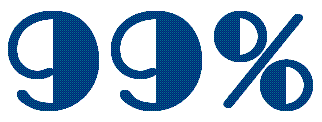99% – is it enough or not?

The work is certainly not over yet and will not be so - there are many reasons why more tests are needed :
- depth coverage improvement – more tests for several assertions are needed;
- there are sentances that are testable, but for several reasons we hadn’t marked them as potentially testable;
- there will be JLS 4 soon, we should start working on it as soon as possible.
Different people might have opposite answers for a question in a title. Most would say "Yes, of course". Indeed 99% is almost 100%. And what is 100% – it is a perfection. 99% looks great, and it is great. But we must understand what this number stands for, and what can be improved. My opinion is "yes, it is great, colossal, tremendous; but no, it’s not enough, I want more, even more than 100%", that’s why I plan to create a script for depth coverage calculation.
Thanks to all SUN developers who did JCK-Lang work, thanks to people who helped (especially to compiler team) and certainly great thanks to all developers who use Java ![]()
Java world became even more compatible and safer!
assertion, Java, Java Language, JLS, language, spec, specification, Sun, TCK, tests